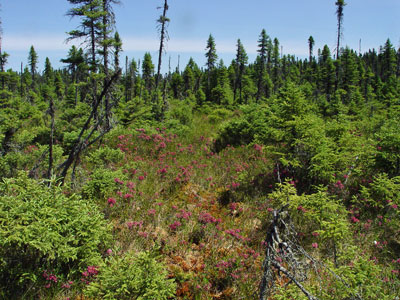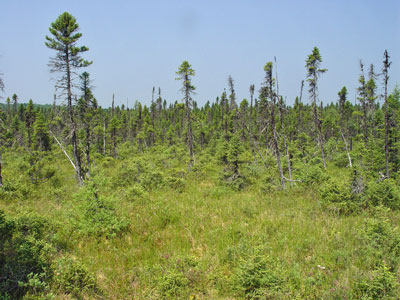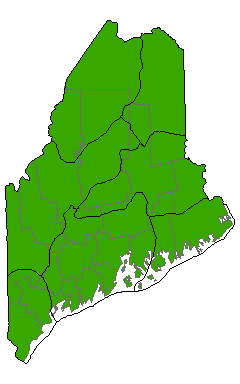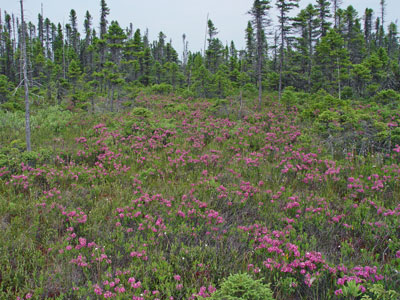DACF Home → Bureaus & Programs → Maine Natural Areas Program → Communities, Plants, and Animals → Natural Community Fact Sheets → Dwarf Shrub Bog
Printer Friendly Fact Sheet - 1 MB pdf (Get a free copy of Adobe Acrobat Reader)
Dwarf Shrub Bog
Scientific Name: Sheep Laurel Dwarf Shrub Bog; State Rank: S5

- Community Description
- Soil and Site Characteristics
- Diagnostics
- Similar Types
- Conservation, Wildlife and Management Considerations
- Distribution
- Characteristic Plants
- Associated Rare Plants
- Associated Rare Animals
- Examples on Conservation Lands You Can Visit
Community Description: A dense layer of dwarf heath shrubs dominates this prototypical open peatland community. Stunted and scattered black spruce and larch trees form <25% cover. Heath shrubs carpet the hummocks and hollows of the peat substrate; sheep laurel or rhodora are typically dominant. Sedges contribute little cover (usually <15%, occasionally 20-25%); the most common is tufted cotton-grass, whose bright white tufts decorate the bog vegetation early in the summer. Insectivorous plants such as pitcher plant and sundew can be quite numerous. The ground surface is covered by a spongy carpet of peat mosses. The floristic composition varies depending upon bog morphology and nutrient availability. Back to top.
Soil and Site Characteristics: This type occurs within raised portions of peatlands, where ombrotrophic conditions prevail (plant growth is raised above the water table, and virtually all nutrients come from precipitation). Although standing water may not be visible, the peat is commonly saturated with water throughout most of the year. The substrate is highly acidic; in the four subtypes recognized by Anderson and Davis (1997) average pH 3.9-4.6. Back to top.

Diagnostics: Open peatland vegetation is raised above the regional water table and dominated by sheep laurel, rhodora, and/or Labrador tea. Leatherleaf is less abundant. Tufted cotton-grass is present. Black spruce is common as scattered trees, but tree cover <25%. Back to top.
Similar Types: Black Spruce Bogs have more trees (canopy >25%). Maritime Huckleberry Bogs also feature sheep laurel, but have patches of dwarf huckleberry and crowberry or deer-hair sedge. These types can grade into each other within a peatland. Other dwarf shrub peatland types occur in more minerotrophic conditions and are dominated by leatherleaf, bog rosemary, and/or shrubby cinquefoil. Subalpine Hanging Bogs and Maritime Slope Bogs share similar vegetation but overlay rock rather than occurring as part of a peatland. Back to top.
Conservation, Wildlife and Management Considerations: This community type is well represented in Maine and is fairly stable in extent, with many examples on public lands and private conservation lands. Peat harvesting is a direct threat to a few sites. Changes to bog hydrology, through impoundment or draining, lead to vegetation changes. Slow vegetation growth rates, due to the nutrient poor environment, result in slow recovery from physical disturbances, such as recreational trail use. If disturbance, such as foot traffic, is a necessity, traversing during frozen conditions or using boardwalks can minimize impacts.
Occurrences of this community type in northwestern Maine may include the bog fritillary butterfly, which uses small cranberry as its larval host plant. The bog elfin butterfly uses black spruce as a larval host plant and may be found in this community when black spruce is abundant. Several dragonfly species may be found in examples of this community where bog pools occur, including the zigzag darner, subarctic darner, and incurvate emerald. Back to top.
Distribution: Common throughout the state, occurring as a large uniform community or as a small component of a complex bog. Extends south and west through northern New England and New York, and northward and eastward into Canada. Landscape Pattern: Small to Large Patch. Back to top.


Characteristic Plants: These plants are frequently found in this community type. Those with an asterisk are often diagnostic of this community.
- Sapling/shrub
- Black spruce*
- Mountain holly*
- Dwarf Shrub
- Black huckleberry*
- Labrador tea*
- Leatherleaf*
- Pale laurel
- Rhodora*
- Sheep laurel*
- Small cranberry
- Herb
- Black spruce*
- Narrow-leaved cotton-grass*
- Pitcher plant
- Tufted cotton-grass*
- Bryoid
- Reindeer lichen*
- Sphagnum mosses*
There are no documented rare animals associated with this natural community.
Examples on Conservation Lands You Can Visit
| Example | County |
|---|---|
| Gassabias Stream, Duck Lake Public Lands | Hancock Co. |
| Harmon Heath, Cutler Public Lands | Washington Co. |
| Number Five Bog Public Lands | Somerset Co. |
| Second Lake, Rocky Lake Public Lands | Washington Co. |
| Sunkhaze Meadows National Wildlife Refuge | Penobscot Co. |
| The Heath, Massabesic Experimental Forest | York Co. |
